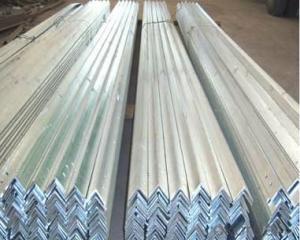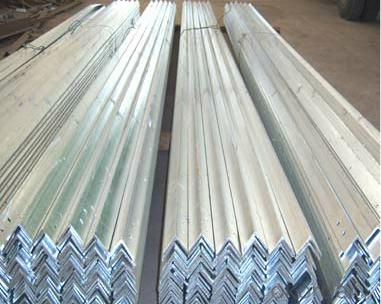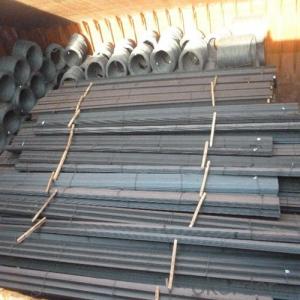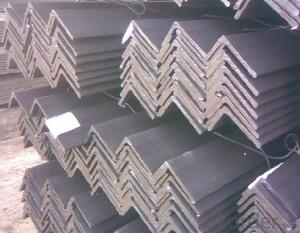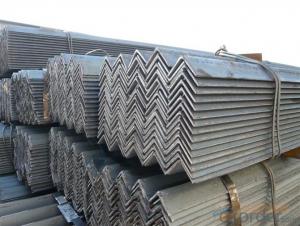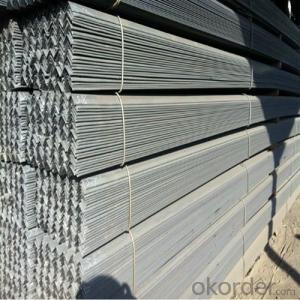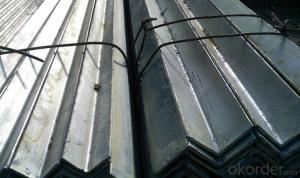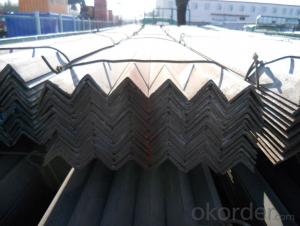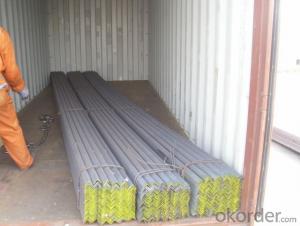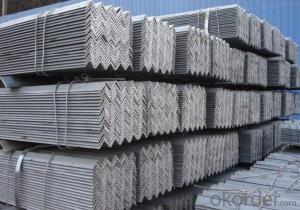Angle Structure Steel Member All Sizes GB
- Loading Port:
- Tianjin
- Payment Terms:
- TT OR LC
- Min Order Qty:
- 25 m.t.
- Supply Capability:
- 50000 m.t./month
OKorder Service Pledge
OKorder Financial Service
You Might Also Like
According to the needs of different structures, Angle can compose to different force support component, and also can be the connections between components. It is widely used in various building structures and engineering structures such as roof beams, bridges, transmission towers, hoisting machinery and transport machinery, ships, industrial furnaces, reaction tower, container frame and warehouse etc.
Sizes: 25mm-250mm | ||
a*t | ||
25*2.5-4.0 | 70*6.0-9.0 | 130*9.0-15 |
30*2.5-6.6 | 75*6.0-9.0 | 140*10-14 |
36*3.0-5.0 | 80*5.0-10 | 150*10-20 |
38*2.3-6.0 | 90*7.0-10 | 160*10-16 |
40*3.0-5.0 | 100*6.0-12 | 175*12-15 |
45*4.0-6.0 | 110*8.0-10 | 180*12-18 |
50*4.0-6.0 | 120*6.0-15 | 200*14-25 |
60*4.0-8.0 | 125*8.0-14 | 250*25 |
Packaging & Delivery
1. Packing: it is nude packed in bundles by steel wire rod
2. Bundle weight: not more than 3.5MT for bulk vessel; less than 3 MT for container load
3. Marks:
Color marking: There will be color marking on both end of the bundle for the cargo delivered by bulk vessel. That makes it easily to distinguish at the destination port.
Tag mark: there will be tag mark tied up on the bundles. The information usually including supplier logo and name, product name, made in China, shipping marks and other information request by the customer.
If loading by container the marking is not needed, but we will prepare it as customer request.
Production flow of Angle Steel
Material prepare (billet) —heat up—rough rolling—precision rolling—cooling—packing—storage and transportation
Grade | Yield Strength,N/mm² | Extension Strength N/mm² | |||
Thickness of Steel,mm | |||||
≦16 | >16-≦40 | >40-≦100 | >100 | ||
SS330 | ≧205 | ≧195 | ≧175 | ≧165 | 330-430 |
SS400 | ≧245 | ≧235 | ≧215 | ≧205 | 400-510 |
SS490 | ≧285 | ≧275 | ≧255 | ≧245 | 490-610 |
SS540 | ≧400 | ≧390 | - | - | ≧540 |
- Q: Can steel angles be used in automotive applications?
- Yes, steel angles can be used in automotive applications. They are commonly used in the construction of vehicle frames, chassis, and suspension components due to their high strength and durability. Steel angles provide stability and support to the structure of a vehicle, making them an essential component in automotive manufacturing.
- Q: Can steel angles be used for signage or billboards?
- Yes, steel angles can be used for signage or billboards. Steel angles are versatile and durable, making them suitable for various applications, including signage and billboards. They provide structural support and stability, ensuring that the signage or billboard remains securely in place. Additionally, steel angles can be easily customized and fabricated to meet specific design requirements. They can be painted or coated to enhance their appearance and protect against corrosion, ensuring longevity and durability for outdoor installations. Overall, steel angles are a reliable and practical choice for signage and billboards.
- Q: What are the common finishes available for steel angles?
- The desired aesthetic appeal and level of protection required will determine the available finishes for steel angles. Common finishes include: 1. Mill finish: The steel angle is left in its natural state after manufacturing, resulting in a rough, gray appearance with minimal corrosion resistance. 2. Hot-dip galvanized: By immersing the steel angle in molten zinc, a protective coating is created on the surface. This finish provides excellent corrosion resistance and is suitable for outdoor applications in harsh environments. 3. Powder coating: Dry powder is applied to the steel angle, then heated and cured to create a durable and decorative coating. Powder coating offers a wide range of colors and textures, along with good corrosion resistance. 4. Painted finish: Various types of paint, such as epoxy, enamel, or acrylic-based coatings, can be used to paint steel angles. Painting provides a decorative finish and can offer some degree of corrosion resistance, depending on the paint type and quality. 5. Stainless steel: Stainless steel angles have a distinct finish that is resistant to corrosion, staining, and rust. They are commonly used in industries like food processing and medicine, where hygiene, aesthetics, and longevity are important. When choosing the appropriate finish, it is important to consider the specific requirements of your project, including the environment and intended use of the steel angle. Consulting with a steel supplier or expert can help determine the best finish for your needs.
- Q: Can steel angles be used for foundation supports?
- Indeed, foundation supports can utilize steel angles. In construction endeavors, steel angles are frequently employed to furnish structural support and stability. Possessing the capacity to endure substantial burdens and offer longevity, steel angles prove themselves ideal for foundation supports. Furthermore, steel angles can be effortlessly linked to other structural elements, like beams or columns, to establish a steadfast foundation system. Moreover, steel angles can be tailored and manufactured to precise measurements and proportions, guaranteeing they conform to the unique prerequisites of the foundation design.
- Q: Can steel angles be used in modular or prefabricated construction?
- Yes, steel angles can be used in modular or prefabricated construction. Steel angles are commonly used as structural components in modular or prefabricated buildings due to their strength, versatility, and ease of installation. They can be easily customized and fabricated to fit specific design requirements, making them suitable for various construction applications in modular or prefabricated projects.
- Q: How do steel angles contribute to the resiliency of a structure?
- Steel angles contribute to the resiliency of a structure by providing additional strength and stability. They are commonly used in construction to reinforce corners and joints, helping to distribute loads and resist bending or twisting forces. This added structural support enhances the overall resilience of the building, making it more resistant to potential hazards such as earthquakes, high winds, or heavy loads.
- Q: Can steel angles be used in high-temperature applications?
- Depending on the alloy and temperature range, steel angles can be utilized in high-temperature scenarios. Stainless steels and heat-resistant alloys, which are specifically engineered for high-temperature applications, possess the ability to endure elevated temperatures without compromising strength or structural integrity. These alloys typically contain elements such as chromium, nickel, or molybdenum, which enhance resistance against corrosion, oxidation, and high temperatures. Nonetheless, it is imperative to acknowledge that not all steel angles are appropriate for high-temperature uses. Ordinary carbon steels, for instance, have a restricted temperature range before experiencing strength loss and becoming vulnerable to deformation or failure. The precise temperature threshold for a specific steel angle relies on factors such as alloy composition, heat treatment, and duration of exposure to high temperatures. To recap, steel angles can be employed in high-temperature applications if they are constructed from suitable alloys specifically designed for such conditions. It is essential to consult materials engineers or experts who can provide guidance on appropriate steel alloys and temperature limits for a given application to ensure performance that is safe and reliable.
- Q: I would like to ask you, angle iron, what does it usually use ah?
- Angle steel manufacturing process is relatively simple, the general large-scale Steel Corp really do not produce this thing, the production process can be divided into two types of hot rolling and cold bending, hot rolling for large size angle steel, cold bending is generally relatively small. Is the standard process for steel billet (such as billet) after steel mill multi special rolling gradually rolled into "shape, material guarantee, there is a transition arc in the medial angle, reliable mechanical performance; while small workshop production is a sheet or strip casting (curved) into the medial angle of no transition arc, but also because it is in the corner of the internal stress of bending into large, mechanical performance is poor, the most important point is that material is not guaranteed, even may be the land of steel, so the angle to buy back is generally not bent, nor welding, up to take long short borehole.
- Q: Can steel angles be used for stair treads?
- Stair treads can indeed utilize steel angles. Known as angle irons as well, steel angles find frequent application in construction and fabrication due to their robustness and resilience. Acting as stair treads, steel angles furnish a firm base for individuals to ascend or descend the stairs. The inclined form of these steel angles enables superior weight allocation and heightened stability. Furthermore, steel angles can be effortlessly welded or bolted to the stair stringers or supports, rendering them a convenient and dependable selection for stair treads.
- Q: How do you calculate the compression capacity of a steel angle?
- In order to determine the compression capacity of a steel angle, it is necessary to take into account various factors, such as the properties of the steel angle and the applied load. The following step-by-step guide outlines the process for calculating the compression capacity: 1. Begin by assessing the properties of the steel angle. This involves noting the angle's dimensions, including length, thickness, and width. Additionally, it is crucial to be aware of the material properties of the steel, including the yield strength and modulus of elasticity. 2. Next, ascertain the effective length of the steel angle. This refers to the unsupported length of the angle. Considering the effective length is critical as it impacts the angle's buckling behavior when subjected to compression. 3. Proceed to compute the slenderness ratio, which is the ratio of the effective length to the radius of gyration of the steel angle. The radius of gyration can be determined based on the angle's dimensions. The slenderness ratio aids in determining the angle's buckling capacity. 4. Determine the critical stress, which is the stress at which the steel angle commences buckling under compression. Euler's formula can be utilized to calculate the critical stress. This formula is expressed as follows: Critical stress = (π^2 * modulus of elasticity * moment of inertia) / (effective length)^2 5. Lastly, calculate the compression capacity, which denotes the maximum load that the steel angle can endure before buckling. This can be accomplished by multiplying the critical stress by the cross-sectional area of the angle: Compression capacity = critical stress * cross-sectional area By following these outlined steps, it becomes possible to calculate the compression capacity of a steel angle. Nonetheless, it is important to note that this approach is a simplified one. For more precise and accurate calculations, it is recommended to refer to relevant design codes, standards, or seek the guidance of a structural engineer.
Send your message to us
Angle Structure Steel Member All Sizes GB
- Loading Port:
- Tianjin
- Payment Terms:
- TT OR LC
- Min Order Qty:
- 25 m.t.
- Supply Capability:
- 50000 m.t./month
OKorder Service Pledge
OKorder Financial Service
Similar products
Hot products
Hot Searches
Related keywords
